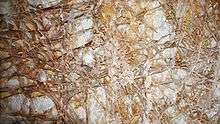Boxwork

Boxwork is an uncommon type of mineral structure, or speleogen (similar to a speleothem, but formed by erosion rather than accretion), occasionally found in caves and erosive environments.
According to KellerLynn, "Boxwork is a speleogen, forming when bedrock between preexisting calcite veins were preferentially weathered away as the cave developed."[1]
Boxwork is commonly composed of thin blades of the mineral calcite that project from cave walls or ceilings that intersect one another at various angles, forming a box-like or honeycomb pattern. The boxwork fins once filled cracks in the rock before the host cave formed. As the walls of the cave began to dissolve away, the more resistant vein and crack fillings did not, or at least dissolved at a slower rate than the surrounding rock, leaving the calcite fins projecting from the cave surfaces.
Some of the most extensive boxwork deposits in the world are found in Wind Cave, Wind Cave National Park in South Dakota, USA. Other outstanding examples occur in Cody Caves, Cody Caves Provincial Park in British Columbia, Canada. Boxwork can also be seen at Jewel Cave National Monument (near Wind Cave), and at Innerspace Caverns near Georgetown, Texas.
References
- ↑ KellerLynn, K. (2009). Wind Cave National Park Geologic Resources Inventory Report, Natural Resource Report NPS/NRPC/GRD/NRR-2009/087. Denver: National Park Service. p. 18.